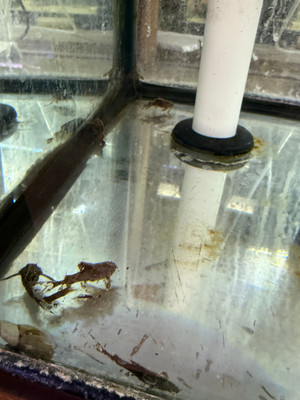Salween Rock Catfish
Posted by Max Gandara on on 15th Jan 2025
Discovering the Salween Rock Catfish
The Salween Rock Catfish, scientifically known as Psilorhynchus balitora, is a fascinating and lesser-known species that inhabits the fast-flowing rivers of Southeast Asia. With its unique adaptations and intriguing behavior, this fish is a subject of interest for ichthyologists and aquatic enthusiasts alike.
Habitat and Distribution
The Salween Rock Catfish is predominantly found in the Salween River, which flows through China, Myanmar, and Thailand. This river is characterized by its rapid currents and rocky substrates, providing the perfect environment for this particular species. The catfish's distribution is largely confined to these areas, making it endemic to the region.
Physical Characteristics
The Salween Rock Catfish is relatively small, typically reaching a length of around 10 centimeters. Its body is elongated and streamlined, allowing it to navigate swiftly through turbulent waters. The fish has a distinctive coloration, with a mix of brown and grey tones, which helps it blend seamlessly with the rocky riverbeds.
One of the most notable features of this species is its strong pectoral and pelvic fins, which it uses to anchor itself against strong currents. Additionally, it has a flattened belly, which aids in maintaining stability on slippery rocks.
Adaptations to Environment
Adaptation is key to the survival of the Salween Rock Catfish. Living in a high-energy environment requires specialized traits, and this fish does not disappoint. Its suction-like mouthparts enable it to cling to rocks while feeding, preventing it from being swept away by the current.
Moreover, its cryptic coloration serves as an excellent camouflage against predators and helps it remain inconspicuous to prey. These adaptations ensure the catfish's survival in a challenging habitat.
Diet and Feeding Habits
The Salween Rock Catfish primarily feeds on algae and small invertebrates. Its feeding habits are closely linked to its habitat, as it scrapes algae off rocks and catches microorganisms present in the fast-moving water. This diet is rich in nutrients, supporting the fish's active lifestyle.
Conservation and Threats
Despite its fascinating adaptations, the Salween Rock Catfish faces several threats. Habitat destruction, due to dam construction and pollution, poses a significant risk to its population. Additionally, climate change and overfishing further exacerbate the challenges this species encounters.
Conservation efforts are essential to protect the Salween Rock Catfish and its habitat. By advocating for sustainable practices and raising awareness about the species, we can help ensure its survival for future generations.
Conclusion
The Salween Rock Catfish is a remarkable example of nature's ingenuity. Its ability to thrive in a demanding environment highlights the importance of understanding and preserving biodiversity. As we learn more about this unique species, we can better appreciate the intricate web of life that sustains our planet.

